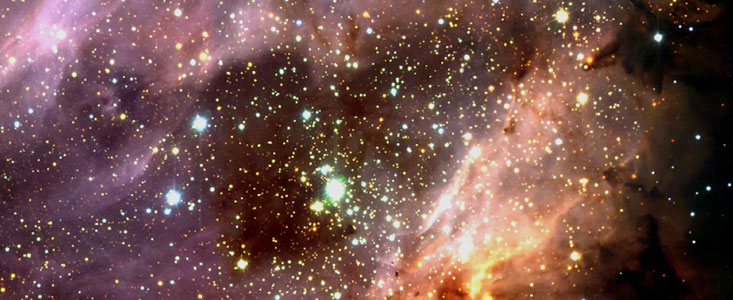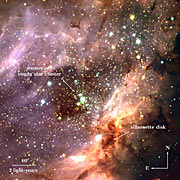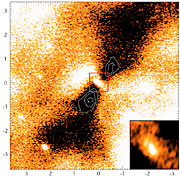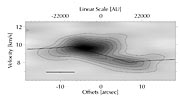Press Release
Shadow of a Large Disc Casts New Light on the Formation of High Mass Stars
Massive Star Observed that Forms through a Rotating Accretion Disc.
12 May 2004
Based on a large observational effort with different telescopes and instruments, mostly from the European Southern Observatory (ESO), a team of European astronomers [1] has shown that in the M 17 nebula a high mass star [2] forms via accretion through a circumstellar disc, i.e. through the same channel as low-mass stars. To reach this conclusion, the astronomers used very sensitive infrared instruments to penetrate the south-western molecular cloud of M 17 so that faint emission from gas heated up by a cluster of massive stars, partly located behind the molecular cloud, could be detected through the dust. Against the background of this hot region a large opaque silhouette, which resembles a flared disc seen nearly edge-on, is found to be associated with an hour-glass shaped reflection nebula. This system complies perfectly with a newly forming high-mass star surrounded by a huge accretion disc and accompanied by an energetic bipolar mass outflow. The new observations corroborate recent theoretical calculations which claim that stars up to 40 times more massive than the Sun can be formed by the same processes that are active during the formation of stars of smaller masses.
The M 17 region
While many details related to the formation and early evolution of low-mass stars like the Sun are now well understood, the basic scenario that leads to the formation of high-mass stars [2] still remains a mystery. Two possible scenarios for the formation of massive stars are currently being studied. In the first, such stars form by accretion of large amounts of circumstellar material; the infall onto the nascent star varies with time. Another possibility is formation by collision (coalescence) of protostars of intermediate masses, increasing the stellar mass in "jumps".
In their continuing quest to add more pieces to the puzzle and help providing an answer to this fundamental question, a team of European astronomers [1] used a battery of telescopes,
mostly at two of the European Southern Observatory's Chilean sites of La Silla and Paranal, to study in unsurpassed detail the Omega nebula.
The Omega nebula, also known as the 17th object in the list of famous French astronomer Charles Messier, i.e. Messier 17 or M 17, is one of the most prominent star forming regions in our Galaxy. It is located at a distance of 7,000 light-years.
M 17 is extremely young - in astronomical terms - as witnessed by the presence of a cluster of high-mass stars that ionise the surrounding hydrogen gas and create a so-called H II region. The total luminosity of these stars exceeds that of our Sun by almost a factor of ten million.
Adjacent to the south-western edge of the H II region, there is a huge cloud of molecular gas which is believed to be a site of ongoing star formation. In order to search for newly forming high-mass stars, Rolf Chini of the Ruhr-Universität Bochum (Germany) and his collaborators have recently investigated the interface between the H II region and the molecular cloud by means of very deep optical and infrared imaging between 0.4 and 2.2 µm.
This was done with ISAAC (at 1.25, 1.65 and 2.2 µm) at the ESO Very Large Telescope (VLT) on Cerro Paranal in September 2002 and with EMMI (at 0.45, 0.55, 0.8 µm) at the ESO New Technology Telescope (NTT), La Silla, in July 2003. The image quality was limited by atmospheric turbulence and varied between 0.4 and 0.8 arcsec. The result of these efforts is shown in eso0416b.
Rolf Chini is pleased: "Our measurements are so sensitive that the south-western molecular cloud of M 17 is penetrated and the faint nebular emission of the H II region, which is partly located behind the molecular cloud, could be detected through the dust."
Against the nebular background of the H II region a large opaque silhouette is seen associated with an hourglass shaped reflection nebula.
The silhouette disc
To obtain a better view of the structure, the team of astronomers turned then to Adaptive Optics imaging using the NAOS-CONICA instrument on the VLT.
Adaptive optics is a "wonder-weapon" in ground-based astronomy, allowing astronomers to "neutralize" the image-smearing turbulence of the terrestrial atmosphere (seen by the unaided eye as the twinkling of stars) so that much sharper images can be obtained. With NAOS-CONICA on the VLT, the astronomers were able to obtain images with a resolution better than one tenth of the "seeing", that is, as what they could observe with ISAAC.
ESO Press Photo eso0416 shows the high-resolution near-infrared (2.2 µm) image they obtained. It clearly suggests that the morphology of the silhouette resembles a flared disc, seen nearly edge-on.
The disc has a diameter of about 20,000 AU [3] - which is 500 times the distance of the farthest planet in our solar system - and is by far the largest circumstellar disc ever detected.
To study the disc structure and properties, the astronomers then turned to radio astronomy and carried out molecular line spectroscopy at the IRAM Plateau de Bure interferometer near Grenoble (France) in April 2003. The astronomers have observed the region in the rotational transitions of the 12CO, 13CO and C18O molecules, and in the adjacent continuum at 3 mm. Velocity resolutions of 0.1 and 0.2 km/s, respectively, were achieved.
Dieter Nürnberger, member of the team, sees this as a confirmation: "Our 13CO data obtained with IRAM indicate that the disc/envelope system slowly rotates with its north-western part approaching the observer." Over an extent of 30,800 AU a velocity shift of 1.7 km/s is indeed measured (eso0416d).
From these observations, adopting standard values for the abundance ratio between the different isotopic carbon monoxide molecules (12CO and 13CO) and for the conversion factor to derive molecular hydrogen densities from the mesured CO intensities, the astronomers were also able to derive a conservative lower limit for the disc mass of 110 solar masses.
This is by far the most massive and largest accretion disc ever observed directly around a young massive star. The largest silhouette disc so far is known as 114-426 in Orion and has a diameter of about 1,000 AU; however, its central star is likely a low-mass object rather than a massive protostar. Although there are a small number of candidates for massive young stellar objects (YSOs) some of which are associated with outflows, the largest circumstellar disc hitherto detected around these objects has a diameter of only 130 AU.
The bipolar nebula
The second morphological structure that is visible on all images throughout the entire spectral range from visible to infrared (0.4 to 2.2 µm) is an hourglass-shaped nebula perpendicular to the plane of the disc (ESO Press Photo eso0416).
This is believed to be an energetic outflow coming from the central massive object. To confirm this, the astronomers went back to ESO's telescopes to perform spectroscopic observations. The optical spectra of the bipolar outflow were measured in April/June 2003 with EFOSC2 at the ESO 3.6 m telescope and with EMMI at the ESO 3.5 m NTT, both located on La Silla, Chile.
The observed spectrum (ESO Press Photo eso0416) is dominated by the emission lines of hydrogen (Hα), calcium (the Ca II triplet 849.8, 854.2 and 866.2 nm), and helium (He I 667.8 nm). In the case of low-mass stars, these lines provide indirect evidence for ongoing accretion from the inner disc onto the star.
The Ca II triplet was also shown to be a product of disc accretion for both a large sample of low and intermediate-mass protostars, known as T Tauri and Herbig Ae/Be stars, respectively. Moreover, the Hα line is extremely broad and shows a deep blue-shifted absorption typically associated with accretion disc-driven outflows.
In the spectrum, numerous iron (Fe II) lines were also observed, which are velocity-shifted by ± 120 km/s. This is clear evidence for the existence of shocks with velocities of more than 50 km/s, hence another confirmation of the outflow hypothesis.
The central protostar
Due to heavy extinction, the nature of an accreting protostellar object, i.e. a star in the process of formation, is usually difficult to infer. Accessible are only those that are located in the neighbourhood of their elder brethren, e.g. next to a cluster of hot stars. Such already evolved massive stars are a rich source of energetic photons and produce powerful stellar winds of protons (like the "solar wind" but much stronger) which impact on the surrounding interstellar gas and dust clouds. This process may lead to partial evaporation and dispersion of those clouds, thereby "lifting the curtain" and allowing us to look directly at young stars in that region.
However, for all high-mass protostellar candidates located away from such a hostile environment there is not a single direct evidence for a (proto-)stellar central object; likewise, the origin of the luminosity - typically about ten thousand solar luminosities - is unclear and may be due to multiple objects or even embedded clusters.
The new disc in M 17 is the only system which exhibits a central object at the expected position of the forming star. The 2.2 µm emission is relatively compact (240 AU x 450 AU) - too small to host a cluster of stars.
Assuming that the emission is due solely to the star, the astronomers derive an absolute infrared brightness of about K = -2.5 magnitudes which would correspond to a main sequence star of about 20 solar masses. Given the fact that the accretion process is still active, and that models predict that about 30-50% of the circumstellar material can be accumulated onto the central object, it is likely that in the present case a massive protostar is currently being born.
Theoretical calculations show that an initial gas cloud of 60 to 120 solar masses may evolve into a star of approximately 30-40 solar masses while the remaining mass is rejected into the interstellar medium. The present observations may be the first to show this happening.
Notes
[1] The team consists of Rolf Chini, Vera Hoffmeister, Markus Nielbock (Astronomisches Institut, Ruhr-Universität Bochum, Germany), Stefan Kimeswenger (Institut für Astrophysik der Universität Innsbruck, Austria), Dieter Nürnberger, Linda Schmidtobreick and Michael Sterzik (ESO, Santiago, Chile).
[2] Astronomers talk about low-mass stars (less than 3 solar masses), intermediate-mass stars (from 3 to 8 solar masses) and high-mass stars (more than 8 solar masses). 1 solar mass = 1.99 1030 kg.
[3] One astronomical unit [AU] is the mean distance between the Sun and the Earth. 1 AU = 149.6 million km.
More information
The research described in this press release is published in the research journal Nature ("The Formation of a Massive Protostar through Disk Accretion of Gas" by Rolf Chini, Vera Hoffmeister, Stefan Kimeswenger, Markus Nielbock, Dieter Nürnberger, Linda Schmidtobreick & Michael Sterzik).
Contacts
Rolf Chini
Astronomisches Institut, Ruhr-Universität Bochum
Bochum, Germany
Tel: +49 234 32-25802
Email: chini@astro.rub.de
Dieter Nürnberger
ESO
Santiago, Chile
Tel: +56 2 463-3080
Email: dnuernbe@eso.org
About the Release
| Release No.: | eso0416 |
| Legacy ID: | PR 12/04 |
| Name: | M 17, Messier 17, Omega Nebula |
| Type: | Milky Way : Star : Grouping : Cluster |
| Facility: | New Technology Telescope, Very Large Telescope |
| Instruments: | ISAAC, NACO |
| Science data: | 2004Natur.429..155C |
Our use of Cookies
We use cookies that are essential for accessing our websites and using our services. We also use cookies to analyse, measure and improve our websites’ performance, to enable content sharing via social media and to display media content hosted on third-party platforms.
ESO Cookies Policy
The European Organisation for Astronomical Research in the Southern Hemisphere (ESO) is the pre-eminent intergovernmental science and technology organisation in astronomy. It carries out an ambitious programme focused on the design, construction and operation of powerful ground-based observing facilities for astronomy.
This Cookies Policy is intended to provide clarity by outlining the cookies used on the ESO public websites, their functions, the options you have for controlling them, and the ways you can contact us for additional details.
What are cookies?
Cookies are small pieces of data stored on your device by websites you visit. They serve various purposes, such as remembering login credentials and preferences and enhance your browsing experience.
Categories of cookies we use
Essential cookies (always active): These cookies are strictly necessary for the proper functioning of our website. Without these cookies, the website cannot operate correctly, and certain services, such as logging in or accessing secure areas, may not be available; because they are essential for the website’s operation, they cannot be disabled.
Functional Cookies: These cookies enhance your browsing experience by enabling additional features and personalization, such as remembering your preferences and settings. While not strictly necessary for the website to function, they improve usability and convenience; these cookies are only placed if you provide your consent.
Analytics cookies: These cookies collect information about how visitors interact with our website, such as which pages are visited most often and how users navigate the site. This data helps us improve website performance, optimize content, and enhance the user experience; these cookies are only placed if you provide your consent. We use the following analytics cookies.
Matomo Cookies:
This website uses Matomo (formerly Piwik), an open source software which enables the statistical analysis of website visits. Matomo uses cookies (text files) which are saved on your computer and which allow us to analyze how you use our website. The website user information generated by the cookies will only be saved on the servers of our IT Department. We use this information to analyze www.eso.org visits and to prepare reports on website activities. These data will not be disclosed to third parties.
On behalf of ESO, Matomo will use this information for the purpose of evaluating your use of the website, compiling reports on website activity and providing other services relating to website activity and internet usage.
Matomo cookies settings:
Additional Third-party cookies on ESO websites: some of our pages display content from external providers, e.g. YouTube.
Such third-party services are outside of ESO control and may, at any time, change their terms of service, use of cookies, etc.
YouTube: Some videos on the ESO website are embedded from ESO’s official YouTube channel. We have enabled YouTube’s privacy-enhanced mode, meaning that no cookies are set unless the user actively clicks on the video to play it. Additionally, in this mode, YouTube does not store any personally identifiable cookie data for embedded video playbacks. For more details, please refer to YouTube’s embedding videos information page.
Cookies can also be classified based on the following elements.
Regarding the domain, there are:
- First-party cookies, set by the website you are currently visiting. They are stored by the same domain that you are browsing and are used to enhance your experience on that site;
- Third-party cookies, set by a domain other than the one you are currently visiting.
As for their duration, cookies can be:
- Browser-session cookies, which are deleted when the user closes the browser;
- Stored cookies, which stay on the user's device for a predetermined period of time.
How to manage cookies
Cookie settings: You can modify your cookie choices for the ESO webpages at any time by clicking on the link Cookie settings at the bottom of any page.
In your browser: If you wish to delete cookies or instruct your browser to delete or block cookies by default, please visit the help pages of your browser:
Please be aware that if you delete or decline cookies, certain functionalities of our website may be not be available and your browsing experience may be affected.
You can set most browsers to prevent any cookies being placed on your device, but you may then have to manually adjust some preferences every time you visit a site/page. And some services and functionalities may not work properly at all (e.g. profile logging-in, shop check out).
Updates to the ESO Cookies Policy
The ESO Cookies Policy may be subject to future updates, which will be made available on this page.
Additional information
For any queries related to cookies, please contact: pdprATesoDOTorg.
As ESO public webpages are managed by our Department of Communication, your questions will be dealt with the support of the said Department.







